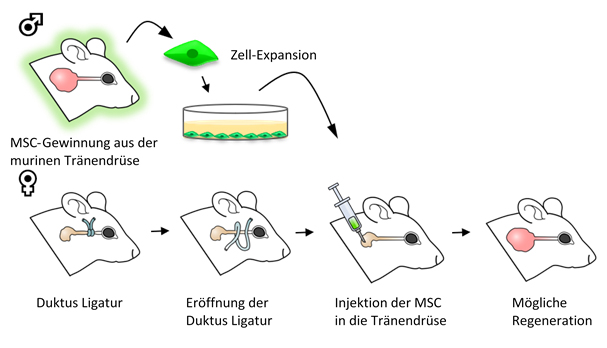Regenerative potential of mesenchymal stem cells from the lacrimal gland
Contact
Director of the Department of Ophthalmology
Head of the Laboratory for Experimental Ophthalmology
Office at Pius-Hospital Oldenburg
Address
Regenerative potential of mesenchymal stem cells from the lacrimal gland
The clinical picture of dry eye is based on a disorder of the tear function unit, which is made up of the ocular surface, the lacrimal glands, the eyelids and the nervous innervation. The most severe forms are mainly caused by a loss of functional lacrimal gland tissue. Current studies describe a high prevalence of five to 50 per cent. Nevertheless, there are currently no curative therapeutic approaches.
Recent studies have demonstrated an intrinsic regeneration potential of the murine lacrimal gland after experimental damage. Regeneration of functional lacrimal gland tissue in situ therefore represents a promising approach for the curative treatment of patients with severe dry eye disease in whom part of the lacrimal gland is still present.
Mesenchymal stem cells (MSC) are currently the focus of regenerative research. A large number of studies have already shown promising results with regard to immune modulation and tissue regeneration following the application of MSC in various target organs. In addition, MSCs have already been detected in the human lacrimal gland. Initial results from our working group also showed an increase in intrinsic MSC after experimental damage to the lacrimal gland in the mouse model. A correlation between the severity of damage and the number of MSCs in the tissue was observed.
The aim of this project is therefore to investigate whether the application of MSC improves the tissue regeneration of the lacrimal gland. To this end, MSC will be transplanted into the lacrimal gland after experimentally induced dry eye in a mouse model. A possible positive effect of MSC on regeneration will subsequently be investigated (immuno-)histologically and at the protein level. The knowledge gained from the experiments can subsequently be used to demonstrate the therapeutic benefits of MSC for the curative treatment of patients with dry eye.
Another approach focusses on the secretome of MSC. The aim here is to investigate whether individual factors secreted by the MSCs can already have a positive effect on the regeneration of the lacrimal gland tissue.

